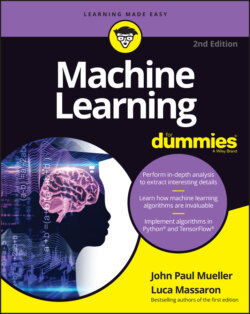Читать книгу Machine Learning For Dummies - John Paul Mueller, John Mueller Paul, Luca Massaron - Страница 3
Machine Learning For Dummies® To view this book's Cheat Sheet, simply go to www.dummies.com and search for “Machine Learning For Dummies Cheat Sheet” in the Search box. Table of Contents
Оглавление1 Cover
2 Title Page
3 Copyright
4 Introduction About This Book Foolish Assumptions Icons Used in This Book Beyond the Book Where to Go from Here
5 Part 1: Introducing How Machines Learn Chapter 1: Getting the Real Story about AI Moving beyond the Hype Dreaming of Electric Sheep Overcoming AI Fantasies Considering the Relationship between AI and Machine Learning Considering AI and Machine Learning Specifications Defining the Divide between Art and Engineering Predicting the Next AI Winter Chapter 2: Learning in the Age of Big Data Considering the Machine Learning Essentials Defining Big Data Considering the Sources of Big Data Specifying the Role of Statistics in Machine Learning Understanding the Role of Algorithms Defining What Training Means Chapter 3: Having a Glance at the Future Creating Useful Technologies for the Future Discovering the New Work Opportunities with Machine Learning Avoiding the Potential Pitfalls of Future Technologies
6 Part 2: Preparing Your Learning Tools Chapter 4: Installing a Python Distribution Using Anaconda for Machine Learning Installing Anaconda on Linux Installing Anaconda on Mac OS X Installing Anaconda on Windows Downloading the Datasets and Example Code Chapter 5: Beyond Basic Coding in Python Defining the Basics You Should Know Storing Data Using Sets, Lists, and Tuples Defining Useful Iterators Indexing Data Using Dictionaries Chapter 6: Working with Google Colab Defining Google Colab Getting a Google Account Working with Notebooks Performing Common Tasks Using Hardware Acceleration Viewing Your Notebook Executing the Code Sharing Your Notebook Getting Help
7 Part 3: Getting Started with the Math Basics Chapter 7: Demystifying the Math Behind Machine Learning Working with Data Exploring the World of Probabilities Describing the Use of Statistics Chapter 8: Descending the Gradient Acknowledging Different Kinds of Learning The learning process Optimizing with big data Chapter 9: Validating Machine Learning Considering the Use of Example Data Checking Out-of-Sample Errors Training, Validating, and Testing Optimizing by Cross-Validation Avoiding Sample Bias and Leakage Traps Chapter 10: Starting with Simple Learners Discovering the Incredible Perceptron Growing Greedy Classification Trees Taking a Probabilistic Turn
8 Part 4: Learning from Smart and Big Data Chapter 11: Preprocessing Data Gathering and Cleaning Data Repairing Missing Data Transforming Distributions Creating Your Own Features Delimiting Anomalous Data Chapter 12: Leveraging Similarity Measuring Similarity between Vectors Using Distances to Locate Clusters Tuning the K-Means Algorithm Finding Similarity by K-Nearest Neighbors Chapter 13: Working with Linear Models the Easy Way Starting to Combine Features Mixing Features of Different Types Switching to Probabilities Guessing the Right Features Learning One Example at a Time Chapter 14: Hitting Complexity with Neural Networks Revising the Perceptron Representing the Way of Learning of a Network Introducing Deep Learning Chapter 15: Going a Step Beyond Using Support Vector Machines Revisiting the Separation Problem Explaining the Algorithm Classifying and Estimating with SVM Chapter 16: Resorting to Ensembles of Learners Leveraging Decision Trees Working with Almost Random Guesses Boosting Smart Predictors Averaging Different Predictors
9 Part 5: Applying Learning to Real Problems Chapter 17: Classifying Images Working with a Set of Images Revising the State of the Art in Computer Vision Extracting Visual Features Recognizing Faces Using Eigenfaces Classifying Images Chapter 18: Scoring Opinions and Sentiments Introducing Natural Language Processing Revising the State of the Art in NLP Understanding How Machines Read Using Scoring and Classification Chapter 19: Recommending Products and Movies Realizing the Revolution of E-Commerce Downloading Rating Data Catching the Limits of Behavioral Data Integrating Text and Behaviors Leveraging SVD
10 Part 6: The Part of Tens Chapter 20: Ten Ways to Improve Your Machine Learning Models Studying Learning Curves Using Cross-Validation Correctly Choosing the Right Error or Score Metric Searching for the Best Hyper-Parameters Testing Multiple Models Averaging Models Stacking Models Applying Feature Engineering Selecting Features and Examples Looking for More Data Chapter 21: Ten Guidelines for Ethical Data Usage Obtaining Permission Using Sanitization Techniques Avoiding Data Inference Using Generalizations Correctly Shunning Discriminatory Practices Detecting Black Swans in Code Understanding the Process Considering the Consequences of an Action Balancing Decision Making Verifying a Data Source Chapter 22: Ten Machine Learning Packages to Master Gensim imbalanced-learn OpenCV SciPy SHAP Statsmodels Modin PyTorch Poetry Snorkel
11 Index
12 About the Authors
13 Advertisement Page
14 Connect with Dummies
15 End User License Agreement
